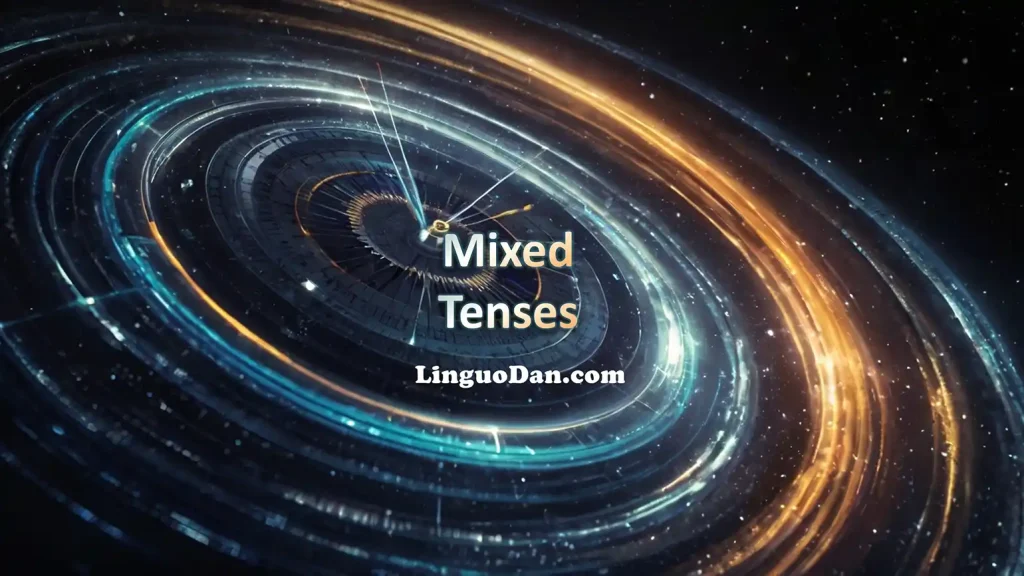Mixed tenses in English: practice (quiz)

Mixed Tenses in English: Practice and Test
Mixed tenses in English are a crucial aspect of correctly expressing sequences of events and relationships between actions occurring at different times. This grammatical concept allows for precise communication of temporal relations in language, creating a clear picture of when and how various actions take place.
Key Points
- Understanding Tense Forms: English has 12 main tense forms, divided into four groups: Simple, Continuous, Perfect, and Perfect Continuous. Each of these forms is used to indicate the time of an action — past, present, or future — as well as to express various aspects of the action.
- Mixed Tenses: Mixed tenses are used to show:
- Sequences of actions
- Duration of events
- Simultaneous events
- Actions that began in the past and continue into the present
- Future actions relative to a past moment
- Importance of Context: When using mixed tenses, it’s crucial to consider the context of the entire statement. Often, the choice of tense depends not only on the specific action but also on its relationship with other actions in the sentence or text.
To quickly review the basic rules for each tense, check out our article: “Table of English Tenses”
Examples and Explanations
Let’s look at examples for a better understanding of mixed tenses:
- Ann ___ that she ___ the visitor before.
- A) thought / saw
- B) thinks / sees
- C) is thinking / sees
- D) thought / had seen
- E) have thought / had seen
Correct answer: D) thought / had seen.
Explanation: This sentence uses a combination of Past Simple (thought) and Past Perfect (had seen). Past Simple (thought) indicates a completed action in the past when Ann thought about something. Past Perfect (had seen) is used to express an action that occurred before another action in the past. In other words, Ann had seen the visitor before the moment she thought about it.
- As it ___ dark we ___ to go home.
- A) gets / decided
- B) would get / shall decide
- C) had got / have decided
- D) was getting / decided
- E) will be getting / had decided
Correct answer: D) was getting / decided.
Explanation: This uses Past Continuous (was getting) and Past Simple (decided). Past Continuous describes a process or action that was ongoing at a specific moment in the past – “it was getting dark”. Past Simple (decided) indicates a specific, completed action in the past – making a decision. This combination of tenses shows that the decision to go home was made against the backdrop of it getting dark.
Additional examples:
- By the time I arrive, they ___ (finish) the meeting. Correct answer: will have finished
- Explanation: This is an example of Future Perfect. This tense form indicates an action that will be completed before a certain point in the future. In this case, the meeting will end before “I” arrive.
- She ___ (study) English for five years before she ___ (move) to London. Correct answer: had been studying / moved
- Explanation: This uses a combination of Past Perfect Continuous and Past Simple. Past Perfect Continuous (had been studying) indicates a continuous action that began and continued up to a certain point in the past. Past Simple (moved) denotes a specific action in the past that occurred after the period of studying English.
- While I ___ (walk) in the park, I ___ (see) an old friend. Correct answer: was walking / saw
- Explanation: This construction uses Past Continuous (was walking) to describe an ongoing action in the past, during which another action, expressed using Past Simple (saw), occurred.
Practical Tips:
- Determine the time context: Before choosing a tense form, identify the overall time context of the situation.
- Pay attention to time markers: Words and phrases like “before”, “after”, “by the time”, “while” often indicate the need to use mixed tenses.
- Consider the sequence of events: Determine which action occurred first, which is ongoing, and which is the result of previous actions.
- Practice regularly: Use a variety of exercises and tests to reinforce your skills in using mixed tenses.
Mastering mixed tenses in English requires understanding the context of each action and choosing the appropriate tense form to accurately convey sequences of events in language. Regular practice with various exercises helps to solidify this knowledge and significantly improve your English language proficiency.
Practice: Mixed Tenses – Let’s practice various English tenses
Let’s move on to practice. Don’t be afraid to make mistakes, as they are an integral part of learning.